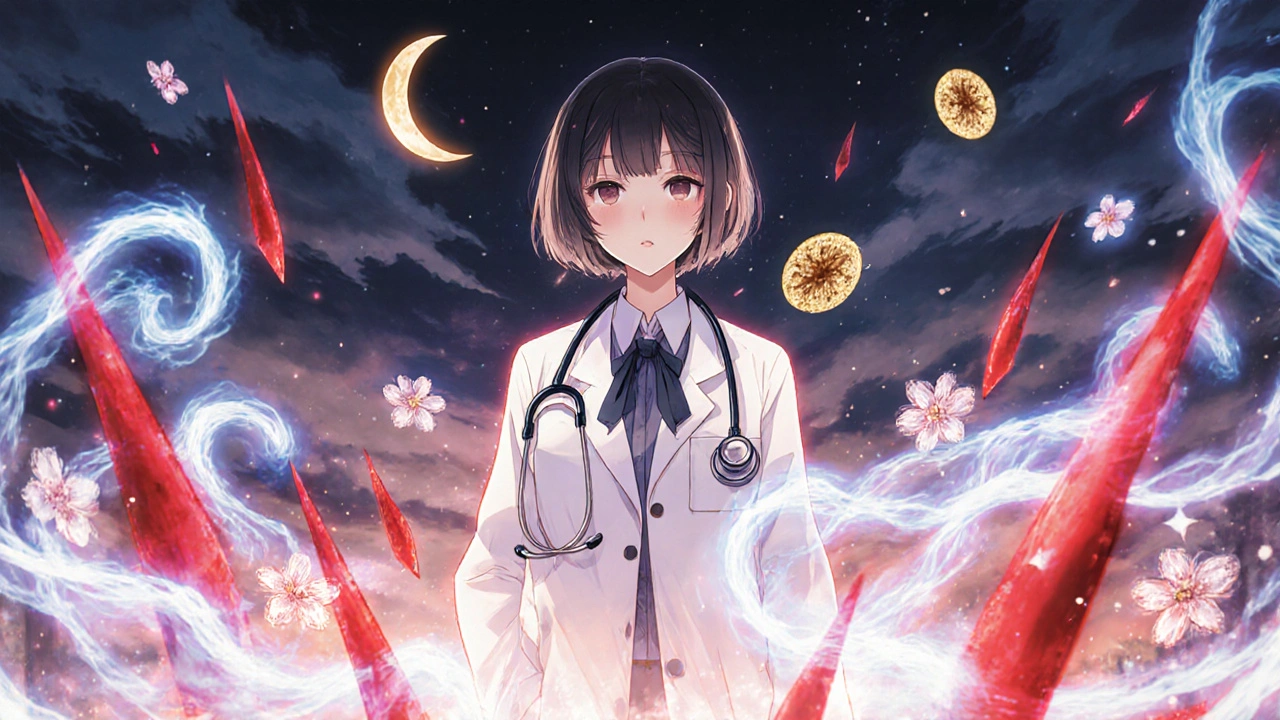
Most people know vitamin D is important for bones, but few realize that the active form-calcitriol-is one of your body’s most powerful immune regulators. It doesn’t just help absorb calcium. It directly talks to immune cells, telling them when to attack and when to stand down. Without enough calcitriol, your immune system becomes either too sluggish or too aggressive, leaving you vulnerable to infections or stuck in chronic inflammation.
What Calcitriol Actually Is
Calcitriol is the hormone version of vitamin D. Your skin makes vitamin D3 when sunlight hits it. Your liver turns that into 25-hydroxyvitamin D, the form doctors test for. But that’s not active yet. Your kidneys convert it into calcitriol-1,25-dihydroxyvitamin D-using an enzyme called 1-alpha-hydroxylase. This final step is what turns a storage molecule into a biological signal.
Unlike other vitamins, calcitriol acts like a steroid hormone. It slips into cells, binds to receptors in the nucleus, and flips genetic switches. That’s why it doesn’t just affect calcium-it reshapes how your immune system behaves.
How Calcitriol Talks to Immune Cells
Your immune system has two main sides: innate (the first responders) and adaptive (the targeted fighters). Calcitriol influences both.
In innate immunity, it boosts macrophages-the cells that swallow up bacteria and viruses. It tells them to make more antimicrobial peptides like cathelicidin. These are natural antibiotics your body produces on the spot. Studies show people with low calcitriol levels have weaker cathelicidin responses, making them more likely to catch respiratory infections.
For adaptive immunity, calcitriol calms down overactive T-cells. It reduces the production of inflammatory cytokines like IL-17 and TNF-alpha, which are linked to autoimmune conditions like multiple sclerosis and rheumatoid arthritis. At the same time, it encourages regulatory T-cells, the peacekeepers that prevent your immune system from attacking your own tissues.
This dual role-boosting defense while preventing self-attack-is why calcitriol is called an immune modulator, not just an immune booster.
Low Calcitriol and Real-World Health Risks
In New Zealand, winter sunlight is weak, especially south of Auckland. Many people drop below 50 nmol/L of 25-hydroxyvitamin D by August. That’s not enough to keep calcitriol levels optimal.
Research from the University of Auckland in 2023 tracked over 1,200 adults during winter. Those with serum calcitriol below 50 pg/mL had 40% more upper respiratory infections than those above 70 pg/mL. The effect was strongest in older adults and people with darker skin, who make less vitamin D from sunlight.
Low calcitriol is also tied to worse outcomes in COVID-19, flu, and even tuberculosis. A 2024 meta-analysis of 17 studies found that patients with the lowest calcitriol levels were 2.3 times more likely to be hospitalized for respiratory illness.
But it’s not just about infections. Low calcitriol is linked to higher rates of autoimmune flare-ups. In people with lupus or type 1 diabetes, restoring calcitriol levels has been shown to reduce disease activity in clinical trials.

How to Get Enough Calcitriol
You can’t get calcitriol from food. Even fatty fish, egg yolks, and fortified milk only give you vitamin D3-the raw material. Your body has to make calcitriol from it.
Here’s what actually works:
- Sunlight: 10-20 minutes of midday sun on arms and legs, two to three times a week, without sunscreen. In Auckland, that’s doable from October to March. In winter, you need supplements.
- Supplements: 1,000-4,000 IU of vitamin D3 daily is safe for most adults. Higher doses (up to 10,000 IU) may be needed if you’re deficient, but only under medical supervision.
- Don’t rely on tanning beds: They emit mostly UVA, which doesn’t make vitamin D. UVB is needed, and most tanning beds lack it.
- Check your levels: Ask your doctor for a 25-hydroxyvitamin D test. Aim for 75-125 nmol/L. That’s the range where calcitriol production works best.
Some people can’t make calcitriol properly-those with kidney disease, certain genetic disorders, or severe obesity. For them, doctors prescribe synthetic calcitriol (brand names like Rocaltrol). This isn’t a supplement-it’s a medication. Dosing is precise. Too much can raise blood calcium dangerously.
When Calcitriol Goes Too Far
More isn’t always better. Excess calcitriol, whether from over-supplementing or kidney disease, causes hypercalcemia. That means too much calcium in your blood. Symptoms include nausea, confusion, frequent urination, and kidney stones. In extreme cases, it can lead to heart rhythm problems or calcification of arteries.
That’s why self-prescribing high-dose vitamin D without testing is risky. A 2025 study in the New Zealand Medical Journal found that 1 in 12 people taking 10,000 IU daily without monitoring developed elevated calcium levels.
Always test before you mega-dose. And if you’re on calcitriol medication, don’t skip follow-ups. Blood calcium and kidney function need checking every 3-6 months.

Calcitriol and Other Immune Factors
Calcitriol doesn’t work alone. It teams up with zinc, selenium, and vitamin A. Zinc helps immune cells respond to calcitriol’s signals. Vitamin A helps regulate the same genes. If you’re low in any of these, calcitriol can’t do its job fully.
That’s why a good diet matters. Eggs, liver, mushrooms, and fortified dairy give you the co-factors. But sunlight and supplements are still the main drivers of calcitriol production.
Also, chronic stress and poor sleep lower calcitriol sensitivity. Cortisol interferes with the vitamin D receptor. So managing stress and sleeping well isn’t just good advice-it’s part of supporting your immune system’s chemical signaling.
Final Takeaway
Calcitriol isn’t a magic bullet, but it’s one of the most important immune regulators your body makes. It’s not about boosting immunity-it’s about balancing it. Too little, and you get sick easily. Too much, and you risk autoimmunity or toxicity.
If you live in a place with seasonal sunlight, like New Zealand, you’re likely running low in winter. Get tested. Take vitamin D3 if needed. Don’t guess. And remember: this isn’t just about preventing colds. It’s about keeping your immune system calm, sharp, and ready to respond-without turning on itself.
Can I get calcitriol from food?
No. Calcitriol is made inside your body from vitamin D3, which comes from sunlight or supplements. Foods like fatty fish, egg yolks, and fortified milk contain vitamin D3, not calcitriol. Your liver and kidneys must convert it.
How do I know if I’m low in calcitriol?
Doctors don’t routinely test calcitriol levels because they’re harder to measure and vary widely. Instead, they test 25-hydroxyvitamin D. If that’s below 50 nmol/L, your calcitriol is likely too low. Symptoms like frequent infections, fatigue, or muscle weakness may suggest deficiency.
Is vitamin D3 the same as calcitriol?
No. Vitamin D3 is the precursor your body makes from sunlight or gets from supplements. Calcitriol is the active hormone form made after your liver and kidneys process it. Think of D3 as raw flour and calcitriol as baked bread.
Can calcitriol help with autoimmune diseases?
Yes, in some cases. Clinical trials show that restoring calcitriol levels can reduce flare-ups in conditions like multiple sclerosis, lupus, and type 1 diabetes. It helps calm overactive immune cells. But it’s not a cure-it’s part of a broader treatment plan, often used with other medications.
How long does it take for calcitriol to improve immune function?
It varies. If you’re deficient, you might notice fewer colds within 4-8 weeks of correcting your vitamin D3 levels. But for immune regulation-like reducing inflammation or stabilizing autoimmunity-it can take 3-6 months of consistent levels to see clear changes.





Comments (12)
Carly Smith
I took vitamin D for a month and my colds stopped but my skin got weirdly dry like i was a lizard
also my husband said i smell like fish now
Kurt Stallings
Calcitriol is just a hormone your body makes when you stop believing in pharmaceuticals
Angie Creed
You speak of calcitriol as if it were a divine messenger, but let us not forget: the body is not a machine, and hormones are not switches. We are woven from ancient rhythms, from sunlight and silence, from the quiet surrender of cells to the cosmic dance of biochemistry. To reduce this to a supplement regimen is to mistake the map for the territory. The immune system does not obey dosage. It remembers. It grieves. It waits. And when we ignore its whispers, it screams in autoimmune fury.
Michael Ferguson
I've been studying this for over a decade and let me tell you, most people don't understand the real issue here. It's not just about vitamin D deficiency, it's about the entire endocrine disruption caused by modern life. Fluoride in the water, EMFs from your phone, glyphosate in your kale, and the fact that you're sitting in a cubicle under LED lights for 12 hours a day - all of it suppresses your 1-alpha-hydroxylase enzyme. I had a patient who took 10,000 IU daily for six months and his calcitriol still didn't budge because he was sleeping in a room with a Wi-Fi router next to his bed. You think sunlight matters? It's the whole ecosystem. And don't even get me started on how sugar spikes kill vitamin D receptor sensitivity. I've seen it firsthand. Your immune system isn't broken - it's betrayed.
Patrick Klepek
So you're telling me the secret to not getting sick is… sunlight? And not taking 17 supplements? Wow. I feel like I've been sold a bill of goods by Big Pharma for the last 10 years. Also, I just checked my fridge - I have three different vitamin D pills. Guess I'm buying a hammock.
Sebastian Brice
I appreciate how you laid this out. I used to be one of those people popping 5000 IU every day because I read it on a blog. Then I got tested - my levels were fine, but I was still tired. Turns out I was low on zinc. Took a simple 15mg supplement and my immune system finally stopped acting like a confused intern. Also, sleep matters more than you think. I used to think I was 'just a night owl' - turns out my cortisol was wrecking my vitamin D receptors. Small changes, big results.
Jim Aondongu
In Nigeria we dont have winter but we still get sick a lot and people take D3 pills like candy
you think calcitriol is the answer but what about clean water and sanitation
your science is good but your priorities are backwards
Michael Schaller
I had a weird reaction last winter. Took 2000 IU daily, felt fine. Then I started taking magnesium and suddenly my energy shot up. Turns out vitamin D needs magnesium to activate. No wonder so many people feel nothing from D3 - they're missing the co-factor. Also, don't forget vitamin K2. It tells calcium where to go. Otherwise you're just making rocks in your arteries.
Kyle Tampier
This is a COVER-UP. Calcitriol is NOT natural - it's a lab-made hormone that Big Pharma uses to control your immune system. They don't want you to know sunlight is free. They want you hooked on blood tests and pills. The CDC knows this. The WHO knows this. And they're all paid by Roche and Pfizer. Check the patents. Look at the funding. This isn't science - it's a cash grab. Don't be fooled.
Tom Caruana
I tried calcitriol after my autoimmune flare 😭 I took 5000 IU and got kidney stones 💀 my doctor was like ‘you’re lucky you didn’t die’ 🤕 now I only get sunlight and cry in the morning 🌞😭 don’t trust anyone who says ‘just take more D’
Muzzafar Magray
You say calcitriol helps autoimmunity but in India we have millions with low vitamin D and no autoimmunity
you ignore genetics and diet
your theory is western privilege dressed as science
Carly Smith
I read this whole thing and still don't know if I should take a pill or just go outside and yell at the sun